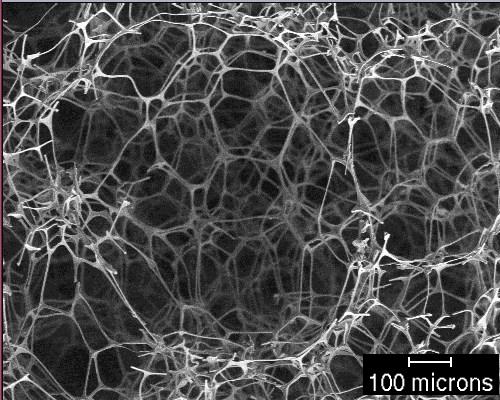"Magic eraser cleaning products do not use any chemicals to clean hard-to-remove marks, but instead act as extremely fine sandpaper."Okay...
There's the argument that every chemist wants to make right now, and many of you are screaming it at your screen already - Everything is a chemcial - but as I said during our recent discussion on chemophobia, that argument is weak and makes chemists sound like they're being dismissive of the actual concern. But this isn't a case of chemophobia. The claims states that magic eraser "does not use any chemicals", but in reality the chemical it does contain is the entire reason it's so cool.
The Mr. Clean Magic Eraser is actually a formaldehyde-melamine-sodium bisulfite copolymer, also called melamine foam. It's a very hard polymer, which is what makes it so good at it's cleaning job. Here's how melamine foam looks under a microscope:
 |
| Image from this blog post. Unknown original source. |
The claim that it works like sandpaper is entirely true. Since melamine is such a hard polymer it easily scratches off most stains. This is also why you don't want to use it on any glossy surfaces - you'll scrape off the gloss coating. If you've ever used melamine foam you've probably been amazed at how well it removes tough stains. Melamine foam is a chemical, and it's just one more way that chemistry makes your life better.
BONUS INTERESTING FACTS:
- Proctor and Gamble filed a patent on marketing melamine foam. That's right - a patent on marketing the foam. Basically, the patent is take melamine foam (which was already a well known cleaning product), put Mr. Clean's face on the front, and sell it to Americans. It's a very odd patent to read through, especially knowing that there's .
- If you love Magic Erasers, don't bother paying the high price to see Mr. Clean's face. Just Instead of paying $1.50 per scrubbing pad you can get them for about 29 cents each. You're welcome.
